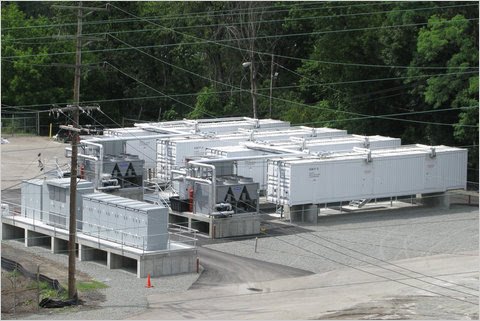
AES Energy Storage As ordered by a computer, the AES Energy Storage plant in Johnson City, N.Y.,
absorbs or delivers energy to the grid at intervals of five seconds with thousands of lithium-ion batteries."Frequency regulation," an esoteric but increasingly important element of the electric system, is getting a new competitor.
Frequency regulation is as critical as voltage control or generating capacity but is not something that most customers notice, at least until it goes catastrophically wrong. It means fine-tuning the system to keep supply and demand in balance.
The problem is that the North American electric grid is supposed to run at 60 cycles, meaning that the electrons change direction 60 times each second. In practice, if electricity supply and demand are not perfectly matched at every instant, the system runs just a little bit too fast or too slow.
If the pace strays too far from 60 cycles per second, equipment like pumps and motors run too fast or too slow and a variety of equipment will shut down to avoid getting damaged. A sharp decline in frequency was one reason that the blackout of August 2003 spread as far as it did.
Traditionally utilities maintained the balance on a gross level by adding or subtracting generation and then fine-tuning by running a steam turbine, usually at a plant that runs on coal, a little faster or a little slower. Those turbines, which have a great deal of inertia at any given moment, could deliver or supply large amounts of energy promptly. But as more electricity generation has shifted to gas turbines, which resemble jet engines and have less inertia, or to wind generators, which tap the fickle breeze, the fraction of plants that can accomplish frequency control has declined.
But on New Year's Eve, AES Energy Storage, the subsidiary of a company based near Washington that operates power plants around the world, opened a plant in Johnson City, N.Y., near Binghamton, that sells frequency regulation. It absorbs or delivers energy at intervals of five seconds, as ordered by a computer at the New York Independent System Operator, which runs the state's grid.
It does so with thousands of lithium-ion batteries, which AES selected for the same reason that electric vehicle manufacturers like them: they have the ability to absorb or deliver large amounts of current promptly and can change direction easily. The batteries were built by A123, which also builds batteries for automobile use.
Batteries are a better bet than turbines, said John M. Zahurancik, vice president of operations and deployment at AES. "You're not revving these big engines up and down, you're running a device that doesn't care if it's run up and down,'' he said.
Meanwhile, in Stephentown, N.Y., near Albany, Beacon Power is working on a plant that will do the same work but while using flywheels.
Providing frequency regulation from coal plants adds somewhat to plants' emissions; but using a flywheel or a battery is cleaner, proponents say. The flywheel system loses about 15 percent of the energy, and the batteries lose about 10 percent, the companies involved report.
The AES project has a federal loan guarantee of $17.1 million, which is close to 80 percent of its cost, according to Mr. Zaharuncik; he declined to give a precise number. The project will eventually be able to absorb or deliver 20 megawatts for a period of up to 15 minutes, although typically it is making much smaller adjustments in each direction, he said.
While the technology could eventually be used to store energy for use at different times of day – say, capturing energy from wind machines at night, when electricity is in surplus, and delivering it during the day, when prices are higher – the regulation market looks like a surer route to profit for the moment. The AES project will eventually use 800,000 batteries, each roughly the size of a D cell, installed in 53-foot shipping containers.
Many places could use frequency regulation, but New York State is drawing these early plants because its system provides for payment to third-party providers of the service.
Wind and solar plants "introduce some additional variability that you don't have with traditional thermal units,'' Mr. Zaharuncik said. With a system that has a lot of renewable energy generators, he explained, "you need some other kind of resource that complements it. ''
